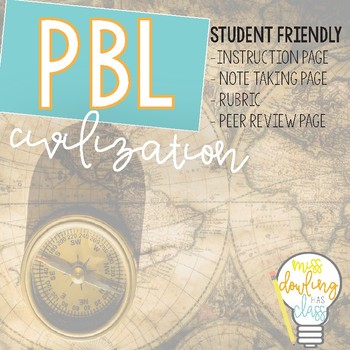Creating an Ancient Civilization PBL | Social Studies Project Based Learning
Blossom Curiosity - Christine Butcher
934 Followers
Grade Levels
4th - 5th
Subjects
Resource Type
Standards
CCSS4.MD.C.5a
CCSS4.MD.C.5b
CCSS4.MD.C.6
CCSS4.MD.C.7
CCSS5.MD.C.3
Formats Included
- PDF
Pages
7 pages
Blossom Curiosity - Christine Butcher
934 Followers
Description
Looking for a fun and engaging way for students to learn about early civilizations? This PBL allows students to create their own ancient civilization. This is a great introduction to learning about ancient Egypt, Greece, Rome, and Mesopotamia.
The project is broken into parts so students can easily stay on track. An instruction and note taking page are included. The product also includes a rubric, peer review forms, and pictures of student's examples will be coming soon.
Throughout the civilization creation, students will:
- Plan an archeology dig site of their civilization to show understanding of area and perimeter
- Design an art piece that would symbolize different parts of their culture which would include specific geometric shapes and key vocabulary
- Design a 3D dwelling and record its specifications so that someone could recreate it
- Determine the civilization's cultural structure
- Create a presentation on their "findings"
See listed standards for most specific math alignment.
Total Pages
7 pages
Answer Key
Rubric only
Teaching Duration
N/A
Report this resource to TPT
Reported resources will be reviewed by our team. Report this resource to let us know if this resource violates TPT’s content guidelines.
Standards
to see state-specific standards (only available in the US).
CCSS4.MD.C.5a
An angle is measured with reference to a circle with its center at the common endpoint of the rays, by considering the fraction of the circular arc between the points where the two rays intersect the circle. An angle that turns through 1/360 of a circle is called a “one-degree angle,” and can be used to measure angles.
CCSS4.MD.C.5b
An angle that turns through 𝘯 one-degree angles is said to have an angle measure of 𝘯 degrees.
CCSS4.MD.C.6
Measure angles in whole-number degrees using a protractor. Sketch angles of specified measure.
CCSS4.MD.C.7
Recognize angle measure as additive. When an angle is decomposed into non-overlapping parts, the angle measure of the whole is the sum of the angle measures of the parts. Solve addition and subtraction problems to find unknown angles on a diagram in real world and mathematical problems, e.g., by using an equation with a symbol for the unknown angle measure.
CCSS5.MD.C.3
Recognize volume as an attribute of solid figures and understand concepts of volume measurement.





